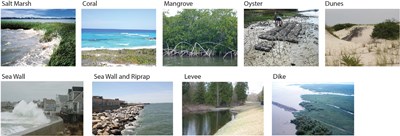Successful Blue Carbon Projects
January 10, 2016 02:15 PM

Types of Blue Carbon
© Ariana Sutton-Grier
CICS-MD scientist Ariana Sutton-Grier and her Hollings Scholar intern, Lindsay Wylie, have documented the keys to a successful Blue Carbon Project in her new article to be published in the March 2016 issue of Marine Policy. “Blue Carbon” encompasses the coastal ecosystems such as salt marshes, seagrasses, and mangroves that mitigate climate change by acting as carbon sinks. Anthropogenic sources have caused degradation to these ecosystems so some areas are implementing blue carbon restoration projects using “carbon credit” financing.
The article describes blue forest and mangrove restoration projects in four countries: Kenya, India, Vietnam, and Madagascar. Their suggestions include:
-
Building in livelihood opportunities into the project, such as sustainable shrimp farming;
-
Getting the local community involved in all stages of planning and implementation;
-
Providing an alternative source of wood for the community to avoid mangrove deforestation outside the project area; and
-
Addressing the potential degradation of the new mangroves by aquaculture and fishing.
The administrative requirements for “carbon credit” financing can be daunting so consider voluntary projects as an alternative.
For scientists, blue carbon projects provide an opportunity to better understand the dynamics of carbon storage. For more information, the final article is available on-line at http://dx.doi.org/10.1016/j.marpol.2015.12.020 . Wylie, Lindsay, Ariana E. Sutton-Grier, and Amber Moore, 2016: Keys to successful blue carbon projects: Lessons learned from global case studies, Mar. Policy, 65, 76–84.
« Back